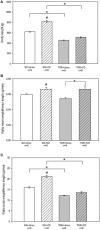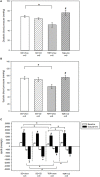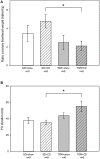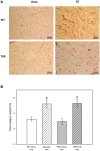Effect of Angiotensin(1-7) on Heart Function in an Experimental Rat Model of Obesity
- PMID: 26733884
- PMCID: PMC4685089
- DOI: 10.3389/fphys.2015.00392
Effect of Angiotensin(1-7) on Heart Function in an Experimental Rat Model of Obesity
Abstract
Aim: Obesity is a risk factor for the development of cardiovascular diseases. Recently it was shown that overexpression of the Mas-receptor antagonist angiotensin(1-7) could prevent from diet-induced obesity. However, it remained unclear whether diet-induced obesity and angiotensin(1-7) overexpression might also have effects on the cardiovascular system in these rats.
Methods: Twenty three male Sprague Dawley rats were fed with standard chow (SD+chow, n = 5) or a cafeteria diet (SD+CD, n = 6) for 5 months. To investigate the effect of angiotensin(1-7) transgenic rats, expressing an angiotensin(1-7)-producing fusion protein in testis were used. These transgenic rats also received a 5 month's feeding period with either chow (TGR+chow, n = 6) or cafeteria diet (TGR+CD, n = 6), respectively. Hemodynamic measurements (pressure-volume loops) were carried out to assess cardiac function and blood pressure. Subsequently, hearts were explanted and investigated according to the Langendorff technique. Furthermore, cardiac remodeling in these animals was investigated histologically.
Results: After 5 months cafeteria diet feeding rats showed a significantly increased body weight, which could be prevented in transgenic rats. However, there was no effect on cardiac performance after cafeteria diet in non-transgenic and transgenic rats. Moreover, overexpression of angiotensin(1-7) deteriorated cardiac contractility as indicated by impaired dp/dt. Furthermore, histological analysis revealed that cafeteria diet led to myocardial fibrosis in both, control and transgenic rats and this was not inhibited by an overproduction of angiotensin(1-7).
Conclusion: These results indicate that an overexpression of circulating angiotensin(1-7) prevents a cafeteria diet-induced increase in body weight, but does not affect cardiac performance in this experimental rat model of obesity. Furthermore, overexpression of angiotensin(1-7) alone resulted in an impairment of cardiac function.
Keywords: angiotensin(1-7); cafeteria diet; heart; obesity; transgenic rats.
Figures





References
LinkOut - more resources
Full Text Sources
Other Literature Sources

